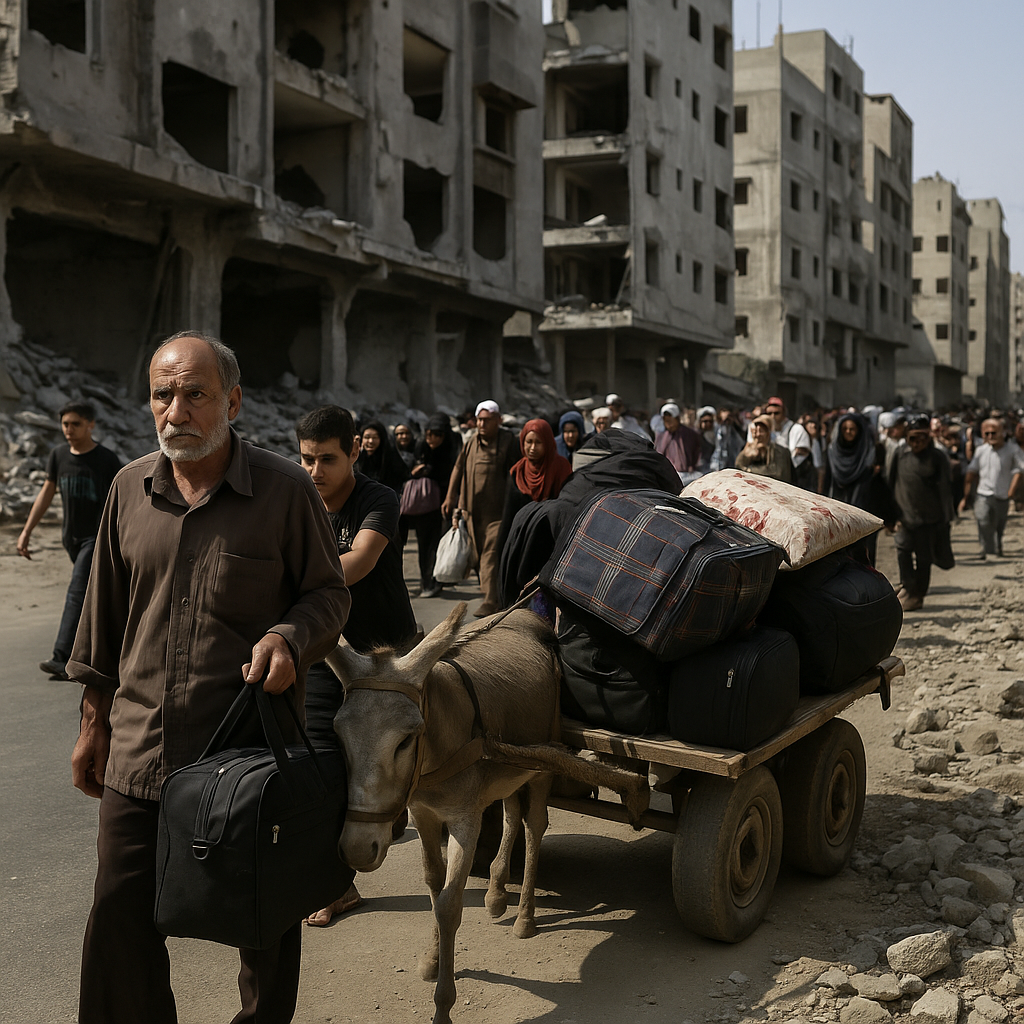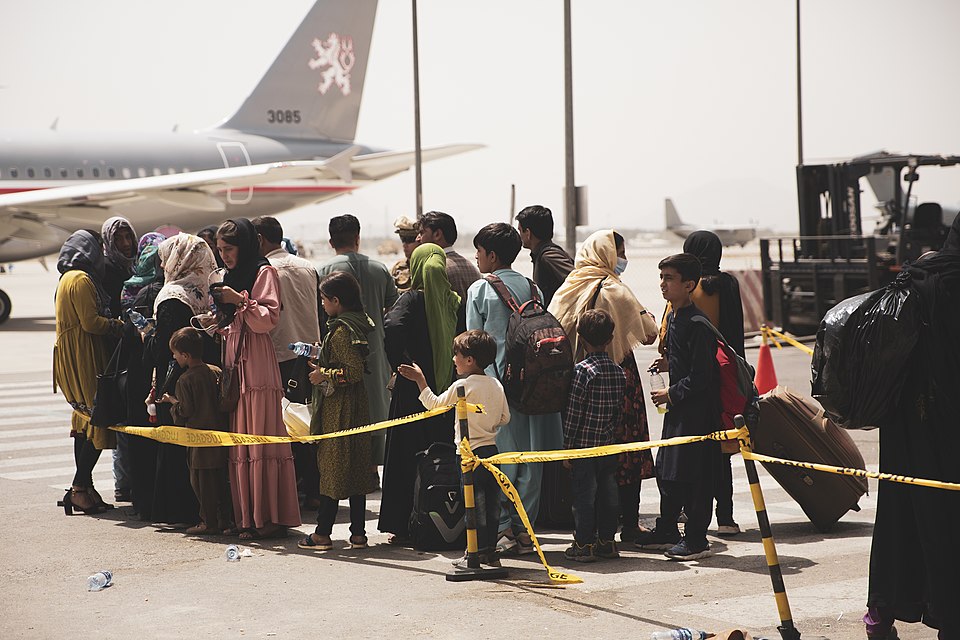Conflict and war can turn routine air travel into chaos. Airports become military targets or get cut off, flights are rerouted or grounded, and baggage systems break down. In peacetime airport delays often mean “lost baggage” or long wait times – irritations most travelers recognize. But in active war zones those problems pale beside destroyed runways, closed airspaces and evacuation panic. As aviation experts note, ordinary “lost baggage” inconveniences are “almost inconsequential” compared to the threats of bombs and missiles (aerosociety.com). Indeed, when fighting erupts, it can strand passengers far from home and leave piles of unclaimed suitcases at ruined terminals.
A memorial cross stands amid destruction in Hostomel, Ukraine (near Kyiv’s Antonov Airport) after intense fighting. The Antonov airport itself was left “peppered with destroyed planes” and wreckage (commons.wikimedia.org). In many war-affected regions, physical damage to airport infrastructure – from runways to baggage carousels – halts normal luggage handling.
Airspace Closures and Airport Damage
In major conflicts, governments often shut civil airspace entirely for safety. For example, Ukraine closed its airspace to commercial flights in February 2022 once war began (reuters.com). Since then no scheduled passenger flights operate to Kyiv, Lviv or any Ukrainian cities, and even foreign overflights are banned. Planes and bags that once moved through hubs like Boryspil or Lviv simply cannot. Similar shutdowns have hit other war zones: Afghanistan’s Kabul airport functioned only briefly during the 2021 evacuation, then closed; in Sudan’s capital Khartoum, heavy fighting disabled the international airport (reuters.com); in Gaza, the long-shuttered civilian airstrip means no commercial flights at all. With airports locked down, passengers must rely on land corridors or distant alternate hubs – often carrying what they can by hand.
When airports become battlefields or military zones, baggage systems grind to a halt. Fuel lines, conveyor belts and baggage trucks can be destroyed or repurposed, and unstaffed terminals fill with abandoned luggage. At Kyiv’s Boryspil International Airport, Reuters photographers found trolleys of abandoned suitcases left outside the locked “Departures” hall after Russia’s invasion halted all flights (reuters.com). Likewise, in Sudan’s capital, drones showed smoke over Khartoum International Airport as artillery rumbled nearby (reuters.com). With runways damaged and control towers dark, even scheduled evacuation flights must park their planes without unloading cargo. One report noted that fierce urban combat in Khartoum “disable[d] the airport and render[ed] some roads impassable,” trapping thousands inside the city (reuters.com). When “the airport [is] closed and skies unsafe, thousands…have also been unable to get out” (reuters.com) – leaving their checked bags in limbo.
Ukraine: Grounded Flights, Stranded Luggage
Ukraine’s war highlights these issues starkly. Before 2022, Kyiv’s two main airports handled dozens of airlines and millions of bags a year; now their conveyor belts sit idle. The forced evacuation of cities has also littered train stations and roads with luggage. After a missile strike at Kramatorsk train station in April 2022, journalists found bodies and “discarded luggage” on the platformbusiness-standard.com. The sight of bloodstained pavement strewn with abandoned suitcases spoke to the panic of sudden flight. Many Ukrainians fleeing by land across the Polish border have little more than a backpack with them, abandoning full checked bags at home or in transit camps. Official repatriation flights through neighboring countries (e.g. trains from Lviv to Poland then flights west) often allowed only hand-carried luggage. As one analysis bluntly states, standard travel headaches like lost baggage are “almost inconsequential” compared to the perils airports face under artillery fireaerosociety.com.
Airlines have largely ceased Ukraine service, so there is no normal baggage claim or customer care. Some carriers have cooperated with governments to help citizens leave by alternative routes, but this rarely includes formal baggage handling. For example, at the height of the conflict many Ukrainians travelled by bus or train to Warsaw or Budapest; any suitcases were physically carried onto trains or offloaded at borders, not processed through usual conveyor belts. As airports reopen gradually (with IATA and regulators setting new safety standards), there is concern over the backlog of lost, damaged or stolen luggage that standard Warsaw/Montreal Convention rules (with liability limited to roughly $1,700 per bag) cannot easily resolve. In the meantime, officials and travelers alike acknowledge that keeping people safe has meant saying “airports first, baggage later.”
Gaza: No Flights, Only Hand-Carry Evacuations
In Gaza there is virtually no civil aviation at all. Gaza’s sole international airport was destroyed in 2001, and since then Palestinians have had no local flights. During the 2023 Israel–Hamas war, the only air evacuations have been one-way: injured patients flown out by Israel or mediators. Most civilians who flee do so overland (to Egypt or into southern Gaza). In practice, this means people can carry only what fits in their arms or small bags. Humanitarian agencies report many Gazans are “forced to drop most of their possessions” when heed evacuation orders, grabbing essentials and family documents only. For example, news photos show Gazans climbing on trucks and donkeys with bundles of belongings tied on top, making do without suitcases or trolleys.
No international baggage rules come into play here, since the travel is informal. Israel’s evacuation orders do not guarantee the transport of checked baggage: people are often directed to leave “immediately and in any direction,” meaning only what you can carry. In practical terms, neighbors share snacks and water, and aid deliveries may include diapers and clothes – but personal belongings remain behind. Aid groups note that any formal luggage system (tags, carousels, claims counters) simply doesn’t exist under blockade conditions. Once hostilities calm, Palestinians returning to Gaza often find their homes and stored belongings ruined or confiscated, a trauma well documented by humanitarian reports.

Sudan: War-Torn Airports and Emergency Evacuations
The brief 2023 Sudanese civil war shut down air traffic just as bloodshed engulfed Khartoum. Satellite images from April 2023 show burning hangars and destroyed airplanes at Khartoum International Airport, evidence that military clashes reached the tarmac (reuters.com). Khartoum’s busy hub suddenly became inaccessible. Western and regional governments scrambled to airlift foreign nationals out, but with the local control tower silent, evacuation flights became ad hoc military missions. Foreign evacuees — governments or militaries — landed on barely-damaged stretches of runway, sometimes using bulldozers to clear holes. Local Sudanese at these airlifts had no defined baggage allowance; reports describe American special forces conducting “VIP-style” evacuations where each family had to leave all belongings behind.
With major airports disabled, alternative routes became crucial. Reuters noted that with Khartoum’s airport closed, “thousands of foreigners – including embassy staff, aid workers and students… have also been unable to get out” (reuters.com). Some evacuees went to Port Sudan on the Red Sea, taking ships or military planes from there; others crossed into Chad or South Sudan by road. In those cases, any luggage had to be carried on buses or trucks. International airlifts (e.g. U.S. C-17s, French A400Ms) prioritized people and critical cargo, often forbidding suitcases. The U.S. Embassy in Khartoum urged American citizens to “travel light,” essentially abandoning all but essential documents.

Emergencies brought unusual uses of baggage infrastructure. For instance, in the U.S.-led Kabul evacuation (similar in chaos to Sudan’s), American Airlines coordinated with Philadelphia Airport to repurpose baggage halls. Terminal baggage-claim areas and tarmac carts were converted into makeshift shelters and processing zones for Afghan evacuees (news.aa.com. In Sudan, relief organizations similarly used empty arrival halls at Port Sudan to triage fleeing civilians. Such improvisation illustrates how airlines and airports try to use their baggage-handling assets even when the normal routes are shattered.
Afghanistan 2021: “Only One Suitcase”
Afghanistan’s 2021 evacuation offers a vivid example of how war constrains baggage. When the Taliban entered Kabul, Western forces organized a massive airlift from Hamid Karzai International Airport. Tens of thousands gathered on the runway, but only a fraction could fly out. BBC reporters on scene described scenes of desperation: “Heading towards every single plane are long queues of Afghans. They have been told they can only bring one suitcase and the clothes they are wearing, as they leave their country behind” (bbc.com). That rule – enforced by U.S. military guards – meant most people left behind bedrooms full of possessions. One evacuee recalled passing a child up a wall to a plane with only a bag of clothes.
Once aboard, evacuees faced minimal luggage allowances. U.S. military C-17s and chartered civilian jets took on families; many men had to stay behind without foreign visas. U.S. and ally militaries did later try to send back some belongings, but logistics were impossible under Taliban restrictions. After Afghanistan fell, even returning flights (for those granted asylum abroad) treated luggage as secondary. The focus was on moving people; missing luggage was simply written off.
No official compensation schemes were announced. Airlines invoked force majeure and the fact that flights into Kabul were under emergency status. Survivors later described having to buy all new clothes and documents. In short, the normal Montreal Convention limits on baggage liability (just $20 per kg lost) had no practical application: there were no functioning ticket desks or baggage offices.
International Rules and Airline Responsibilities
In theory, international air law (the Warsaw/Montreal Conventions and IATA agreements) obligate carriers to handle baggage carefully and compensate passengers for loss. In practice, war zones fall outside normal rules. IATA Resolution 753 (from 2018) requires bag-tracking at every transfer point, but when flights are cancelled or airports destroyed, tracking collapses. Airlines’ legally mandated liability (roughly 1,000–1,700 SDRs, or about $1,500–$1,800) is often dwarfed by war losses – and there may be no airline remaining to claim against.
IATA and ICAO condemn attacks on civilian airports (iata.org) and insist on safe passage for relief. But even if combatants respect these rules, baggage itself often falls through the cracks. For example, if an airport closes overnight, carriers may abandon wheelchairs, strollers and checked bags in locked terminals; passengers only recover whatever staff can retrieve later. In many conflicts, airlines explicitly warn passengers that routine baggage promises are suspended. Travel advisories often mention “no checked baggage allowed” or waive restrictions – effectively telling people they cannot expect normal service.
Some governments step in during evacuations. For instance, during the 2021 Afghan crisis the U.S. military maintained hotlines and casework centers for lost documents and personal items. The U.S. also flew back valuables (like embassy equipment) by military cargo plane. In Ukraine, the government set up a hotline for missing refugees and luggage claims, but admitted many lost items cannot be returned. Certain airlines have offered one-time waivers: e.g. charter flights for evacuees often allow an extra bag or two with no fee. But compensation for war-related baggage loss is typically “handled on a case-by-case basis,” usually by government aid rather than airline checks.

Afghan evacuees line up for a flight at Kabul Airport in August 2021, each with minimal luggage. Most are carrying just one suitcase or backpack, as military guards told them they could only bring “one suitcase and the clothes they are wearing” (bbc.com).
Mitigating Loss and Moving Forward
Airlines and airports have a limited toolbox against these problems. Some carriers maintain lists of evacuees and try to reunite any stranded baggage once flights resume. During downtime they may safeguard stored luggage in warehouses (as Ukraine is reportedly doing), or transfer it to partner airports. In rare cases, governments authorize humanitarian flights to collect valuables: Ukraine, for example, discussed using grain-shipment insurance funds to cover parts of air-travel costs, potentially including cargo aircraft that might retrieve cargo from conflict zones (reuters.com).
In the end, most conflict-zone baggage loss is absorbed as part of the war cost. Travel insurance policies often have war exclusions; standard airline contracts disclaim liability for “acts of war.” Victims may eventually petition international courts, but evidence of loss amid rubble is scarce. Journalists and aid workers emphasize that during evacuations the priority is human lives, not luggage. As one Marine Corps officer noted during the Kabul airlift, caring for evacuees was the mission’s goal – baggage was an afterthought.
Yet the human toll can be measured even in missing suitcases. Each abandoned bag in Hostomel or Kabul represents a displaced family. Passengers describe feeling “ghostly” at Western airports, waiting in limbo for bags that will never arrive. For travelers and aviation workers alike, these images are stark reminders: in a war zone, even your luggage can become collateral damage.


